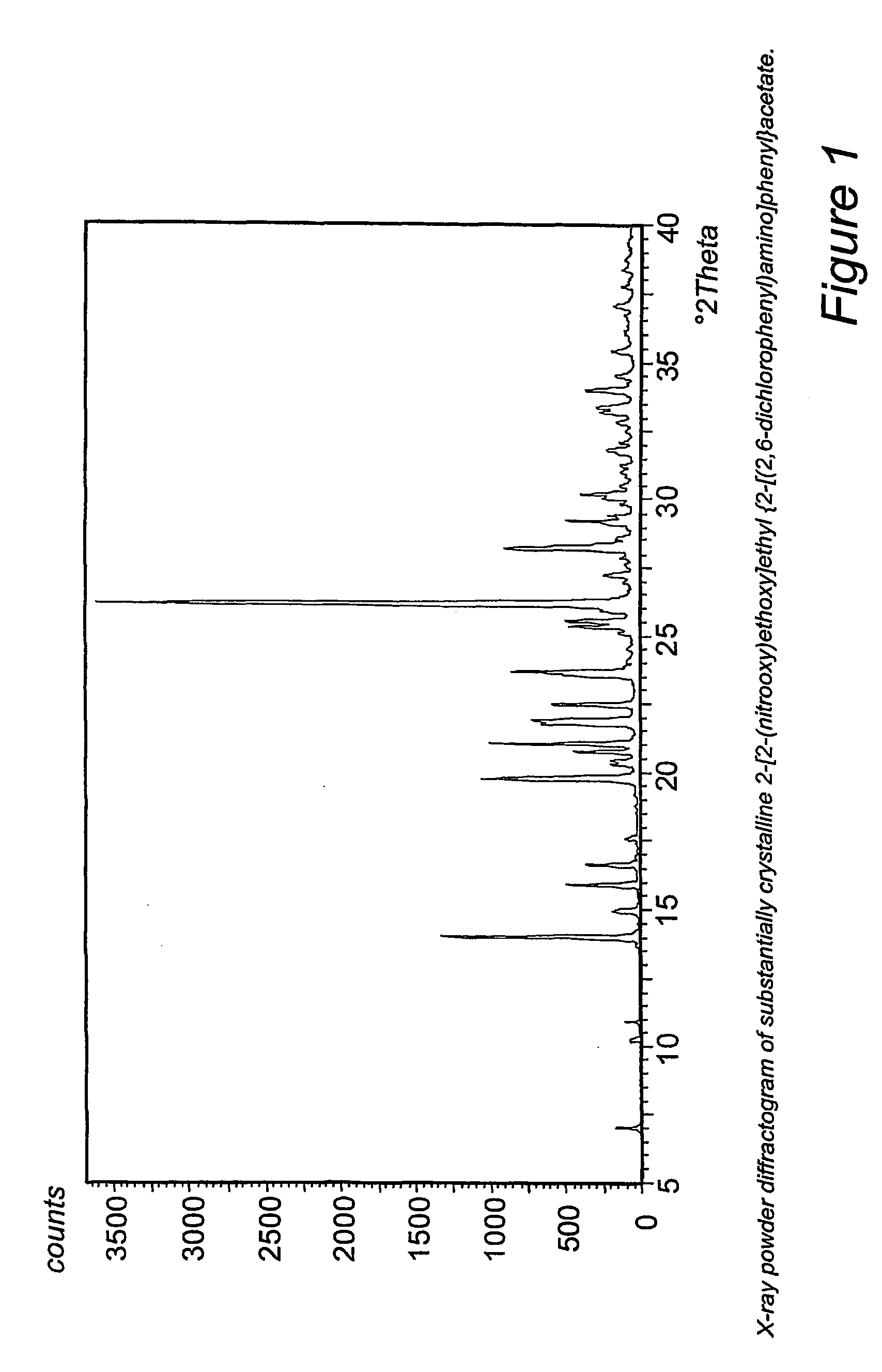Manufacturing process for no-donating compounds such as no-donating diclofenac
a manufacturing process and compound technology, applied in the field of new, can solve the problems of unsuitable large-scale production, unsafe large-scale production use of tetraalkylammonium nitrate sources used in stoichiometric amounts, and less suitable large-scale production of process
- Summary
- Abstract
- Description
- Claims
- Application Information
AI Technical Summary
Benefits of technology
Problems solved by technology
Method used
Image
Examples
example 1
Synthesis of 2-[2-(nitrooxy)ethoxy]ethyl (2-[(2,6-dichlorophenyl)amino]phenyl}acetate (compound of formula IVa).
[0219] 2-(2-hydroxyethoxy)ethyl {2-[(2,6-dichlorophenyl)amino]phenyl}acetate (compound of formula IIa).
[0220] Diclofenac sodium (20 g, 63 mmol) was dissolved in diehyleneglycol (67 g, 0.63 mol) at 60° C. Toluene (170 mL) and conc. sulfuric acid (4.5 mL, 81.7 mmol) were added after the solids had dissolved. The reaction mixture was heated at 60° C. for 14 h before addition of K2CO3 (1 M, 120 mL). After phase separation the aqueous phase was discarded and the organic phase was washed with water (100 mL). The organic phase was concentrated under vacuum to give 23 g of Ia as a brown oil (85% yield, 90%-area HPLC-purity) to be used in the next step. MS [M+]=384; 1H-NMR (CDCl3) δ 7.34 (app d, J=8 Hz, 2H), 7.24 (app d, J=8 Hz, 1H), 7.12 (app t, J=7 Hz, 1H), 6.92-7.05 (m, 2H), 6.88 (br s, 1H), 6.54 (app d, J=8 Hz, 1H), 4.32 (app t, J=4 Hz, 2H), 3.85 (s, 2H), 3.64-3.76 (m, 4H), 3...
example 2
Synthesis of 4-(nitrooxy)butyl {2-[(2,6-dichlorophenyl)amino]phenyl}acetate (compound of formula IVb)
[0233] 4-Hydroxybutyl {2-r(2,6-dichlorophenyl)amino]phenyl}acetate (compound of formula IIb).
[0234] To a mixture of Diclofenac sodium (20.0 g, 62.9 mmol) and 1,4-butanediol (56.6 g, 629 mmol) in toluene (120 mL) at 65° C. was added sulfuric acid (4.5 mL, 84.5 mmol). The resulting clear solution was stirred at 65° C. over 6 h before cooling to 50° C. The reaction mixture was washed with aqueous potassium bicarbonate (0.2 M, 120 mL) and water (2×120 mL). After phase separation the toluene was evaporated giving 22.9 g IIb as a brown oil (88%, HPLC purity of at least 89%-area), which was used in the next step. 1H-NMR (CDCl3) δ 7.34 (app d J=8 Hz, 2H), 7.23 (app d, J=8 Hz, 1H), 7.13 (app t, J=7 Hz, 1H), 6.97 (app q, J=8 Hz, 2H), 6.56 (app d, J=8 Hz, 1H), 4.19 (t, J=7 Hz, 2H), 3.82 (s, 2H), 3.63 (t, J=7Hz, 2H), 1.71-1.80 (m, 2 H), 1.55-1.64 (m, 2H); 13C-NMR (CDCl3) δ 172.4, 142.6, 137.7,...
example 3
Synthesis of 2-{2-[2-(nitrooxy)ethoxy]ethoxy}ethyl {2-[(2,6-dichlorophenyl-)amino]-phenyl}acetate (compound of formula IVc).
[0239] 2-[2-(2-Hydroxyethoxy)ethoxy]ethyl {2-[(2,6-dichlorophenyl)amino]phenyl}acetate (compound of formula IIc).
[0240] Thionyl chloride (1.2 mL, 16.9 mmol) was added to a suspension of Diclofenac (10 g, 33.8 mmol) and triethylene glycol (90 mL, 676 mmol) at 30° C. The reaction was stirred for 7 h before addition of aqueous potassium carbonate (0.27 M, 100 mL) and toluene (100 mL). The temperature was increased to 60° C. and the water phase was discarded. The organic phase was washed with water (3×100 mL) and concentrated to give 14.4 g of IIc as an oil. This oil was used directly in the next step. 1H-NMR (CDCl3) δ 7.33 (app d, J=8 Hz, 2H) 7.23 (app d, J=7 Hz, 1H), 7.08-7.20 (m, 1H), 6.85-7.07 (m, 3H), 6.54 (app d, J=8 Hz, 1H), 4.31 (app t, J=5 Hz, 2H), 3.85 (s, 2H), 3.71 (m, 4 Hz, 4H), 3.54-3.64 (m, 4H), 2.50 (app br s, 1H); 13C-NMR (CDCl3) δ 172.4, 142.8, 1...
PUM
| Property | Measurement | Unit |
|---|---|---|
| temperature | aaaaa | aaaaa |
| temperature | aaaaa | aaaaa |
| chromatographic purity | aaaaa | aaaaa |
Abstract
Description
Claims
Application Information
 Login to View More
Login to View More - R&D
- Intellectual Property
- Life Sciences
- Materials
- Tech Scout
- Unparalleled Data Quality
- Higher Quality Content
- 60% Fewer Hallucinations
Browse by: Latest US Patents, China's latest patents, Technical Efficacy Thesaurus, Application Domain, Technology Topic, Popular Technical Reports.
© 2025 PatSnap. All rights reserved.Legal|Privacy policy|Modern Slavery Act Transparency Statement|Sitemap|About US| Contact US: help@patsnap.com



